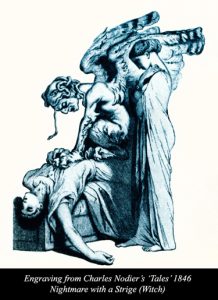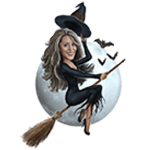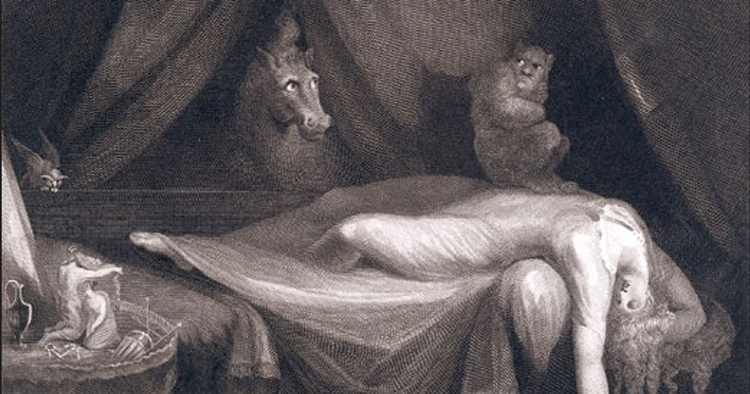Sleep Paralysis Awareness Week – why things go bump in the night
Since this is Halloween week, let’s talk about one of the major natural contributors to the folkore of the macabre: sleep paralysis.
 Have you ever woken up and experienced several of the following together:
Have you ever woken up and experienced several of the following together:
• Correctly perceived your surroundings, that is to say, known you weren’t in a dream?
• Felt that you couldn’t move?
• Possibily felt that you were having difficulty breathing, or that something
was pressing down on your chest?
• Felt intense fear?
• Seen or heard other people/things, perhaps threatening, in the room which faded away when you recovered your ability to move?
This is sleep paralysis (SP). Estimates vary, but it seems that it may happen once to between 25 and 50% of us. When I do talks, I always ask for a show of hands, and I’d say it’s usually closer to the 40% mark than lower. The wide range of figures we have may be due to difficulties with terminology during questioning. (p 385)
In case you want to just go straight to the bit you’re interested in, here are some hyperlinks around the rest of this article:
• Folkloric creatures that have been inspired by SP
• Tips for avoiding SP
• Leave your comment or personal account of SP here
Here are a few descriptions of SP:
“Persons suffering from an attack suffer an incapability of motion, a torpid sensation in their sleep, a sense of suffocation and oppression, as if from one pressing them down, with inabability to cry out, or they utter inarticulate sounds. Some imagine often that they even hear the person who is going to press them down, that he offers lustful violence to them but flies when they attempt to grasp him with their fingers”
Paulus Aegineta, Physician in Roman Alexandra“ … a difficult respiration a violent oppression on the breast, and a total privation of bodily motion … In this agony they sigh, moan, utter indistinct sounds, and remain in the jaws of death, til, by the utmost efforts of nature, or some external assistance, they escape out of that dreadful, torpid state. As soon as they shake of that vast oppression, and are able to move the body, they are affected with strong Palpitation, great Anxiety, Langour and Uneasiness”
J Bond
An Essay on the Incubus, or Nightmare 1753“ … one passion is almost never absent – that of utter and incomprehensible dread … In every instance, there is a sense of oppression and helplessness … he [the victim – J] can hardly drag one limb after another … his blows are utterly ineffective”
R. Macnish
The Philosophy of Sleep 1834
And Guy de Maupassant also gives a perfect fictional description in Le Horla:
“I sleep – for a while – two or three hours – then a dream – no – a nightmare seizes me in its grip, I know full well that I am lying down and that I am asleep… I sense it and I know it… and I am also aware that somebody is coming up to me, looking at me, running his fingers over me, climbing on to my bed, kneeling on my chest, taking me by the throat and squeezing… squeezing… with all its might, trying to strangle me. I struggle, but I am tied down by that dreadful feeling of helplessness which paralyzes us in our dreams. I want to cry out – but I can’t. I want to move – I can’t do it. I try, making terrible, strenuous efforts, gasping for breath, to turn on my side, to throw off this creature who is crushing me and choking me – but I can’t! Then, suddenly, I wake up, panic-stricken, covered in sweat. I light a candle. I am alone.”
The International Classification of Sleep Disorders, Revised: Diagnostic and Coding Manual describes it this way: (p 39)
“Sleep paralysis is a transient, generalized inability to move or to speak during the transition between sleep and wakefulness. The patient usually regains muscular control within a short time (one to several minutes). Sleep paralysis is a frightening experience, particularly when initially experienced, and often is accompanied by a sensation of inability to breathe. Episodes often occur with hypnagogic hallucinations, and thus the frightful emotional experience is intensified.
The good news is that very few people will have several attacks in their lives, and only a very tiny minority will have chronic difficulty.
Basically, SP is when your REM (dreaming) cycle intrudes into wakefuness so that you experience sleep phenomena (dream hallucinations; muscular paralysis) simultaneously with waking phenomena (awareness of your own body; awareness of your surroundings). There may be a genetic predisposition, but it usually occurs when sleep cycles are disturbed: for example, in people who are doing shift work or taking afternoon naps. It is commonly suffered by narcoleptics, but you don’t have to be narcoleptic to have an attack, or even several.
And although the word ‘nightmare’ now just means ‘bad dream’, it’s clear from the records that it originally referred to sleep paralysis: p 54
“The word nightmare was originally used in its saxon derived meaning of “crusher” (mara) and continued to be used this way into the seventeenth century. Since then, it was extended to encompass bad dreams.”
Sleep paralysis has accounted for many historical accounts and folkloric
creatures. Here are a few examples:
Witches
 Cottom Mather (The Salem Witches) reported that Richard Coman was ‘witch-ridden’ by Bridget Bishop p 221 Cotton Mather (from the Salem Witch trials) On Witchcraft: Being the Wonders of the Invisible World, he writes that Bridget Bishop had allegedly “ridden a man”. A Richard Coman testified that “eight years ago, as he lay awake in his bed, with a light burning in the room, he was annoyed with the apparition of this Bishop and of two more that were strangers to him, who came and oppressed him so, that he could neither stir himself, nor wake anyone else”
Cottom Mather (The Salem Witches) reported that Richard Coman was ‘witch-ridden’ by Bridget Bishop p 221 Cotton Mather (from the Salem Witch trials) On Witchcraft: Being the Wonders of the Invisible World, he writes that Bridget Bishop had allegedly “ridden a man”. A Richard Coman testified that “eight years ago, as he lay awake in his bed, with a light burning in the room, he was annoyed with the apparition of this Bishop and of two more that were strangers to him, who came and oppressed him so, that he could neither stir himself, nor wake anyone else”
Ghosts
Traditional account of ghosts pulling the covers off sleepers are common: I’ve experienced it myself. Here’s an account via Montague Summers from his The Vampire in Europe
“A miller at D—had a healthy servant boy who soon after entering his services began to fail. He aquired a ravenous appetite but nevertheless grew daily more feeble and emaciated. Being interrogated, he at last confessed that a thing which he could not see, but which he could plainly feel, came to him every night about twelve o’ clock and settled upon his chest, drawing all the life out of him, so that he bacame paralised [sic] for the time being, and neither could move nor cry out. Thereupon the miller agreed to share the bed with the boy, and made him promise that he should give a certain sign when the vampire arrived. This was done, and when the signal was made the miller putting out his hands grasped an invisibale but very tangible substance that rested upon the boy’s chest. He described it as apparently eliptical in shape, and to the touch feeling like gelatine, properties which suggest an ectoplasmic formation. The thing writhed and fiercely struggled to escape, but he gripped it firmly and threw it on the fire. After that, the boy recovered and there was an end of these visits.”
Vampires
The vampiric ghost, the Shoemaker of Silesia, had committed suicide but still had the benefit of the proper religious rituals as his family had hidden the means of his demise. It is strongly implied that the ghosts did not rest because he had had those rituals to which, as a suicide, he was not entitled.
He attacked “… after sundown, and since no one was free of it, everyone looked around constantly for it. The ones most bothered were those who wanted to rest after heavy work; often it came to their bed, often it actually lay down in it and was like to smother the people.”1
One of the classic folkoric vampires, Peter Plogojowitz had “Come to (his victims) in their sleep”. This account come to us from the Imperial Provisor of Gradisk District where Plogojowicz had lived, died, and then been exhumed, staked and cremated by his nervous neighbours.
Incubi and Succubi
There is sometimes another aspect to sleep paralysis, a sexual aspect which may be experienced as either pleasurable or as an assault.
There were undoubtedly many factors which led to the idea of sexual demons called incubi and succubi: the Roman Catholic Church’s extraordinarily strictured attitude to sex, and sexism in general, among them.
But there’s also an element of SP which is obvious as soon as you know about it. Here’s an account of a succubus attacking a man, via Reginald Scot from a man named Jason Pratensis:
“There commeth unto me, almost every night, a certain woman, unknown unto me, and lieth so heavy upon my breast, that I cannot fetch my breath, neither have any power to cry, neither do my hands serve me to shove her away, nor my feet to go from her”
Interpretation of sleep paralysis as demonic attack is unfortunately still a modern phenomenon. A copy of City News (a publication by the Universal Church of the Kingdom of God, an international Pentacostal organisation of Brazilian origin) from within the last couple of years carries this story on the problem page:
“This may sound bizarre and unbelievable, but since a long-term relationship break up I have been getting feelings of something having sex with me. I can fell myself being pushed down and this thing on top of me …”
To which the advice was:
“I certainly do believe you and trust me when I say that you are not the only one that is going through this problem. Surprisingly, it’s quite common but people are often embarrassed to seek help for it and often, if they do seek help, they do so in the wrong places. The good news is that we have helped thousands of people overcome this problem. As it is a spiritual problem and not a physical one, it must be fought using spiritual weapons. I would like to invite you to participate in our Friday services for spiritual cleansing. You will receive strong prayers against all negativity and to break any curse. A pastor will be able to give you advice on what else you will need to be totally free from these attacks.”
UFOs
Paralysis and sexual attack are often reported together. Indeed, aliens seem absurdly obsessed with our reproductive apparatus. Take this account from ‘Jerry’ quoted by John E. Mack (p 118)
“She woke up terrified and remembered pressure in the abdomen and genital area and that she could not move. ‘In my head I was screaming’ Jerry remembers, but does not know if any sound came out. ‘Somebody was doing something’, she recalled, but it was ‘something alien’. Although she recalls wondering to herself, ‘Is that how sex is done?’”
It was suggested in the past by the ancient Greek physician Galen that Nightnare/SP was caused by gastric disturbance which is why your Mum might have told you not to eat cheese before bedtime. The psycho-analytic tradition thought that it was due to repressed desires. We now know that it’s just a harmless, but very scary, sleep disturance.
In our culture, sleep paralysis passes mostly under the radar. Considering how many of us will experience it at some point, not many know about it. Apart from the sexual element, are there other factors which help to make sleep paralysis such a secret affliction? It’s been noted by many researchers that collecting information about sleep paralysis has been easiest in cultures that are accepting of it and therefore have a language for it. In his introduction, Hufford noted that in discussions with his wife:
“… she has shared with me the odd feeling of working on a subject for which there is no really useful English vocabulary”
… which is why he wrote his book about Newfoundlers – people of English and Irish extraction with a distinct culture, who already had the appropriate terminology and discourses in place. In our rational post-Enlightenment world, it may every bit as embarrassing for many people to admit they’ve even had an encounter with a supernatural entity, let alone had sex (consenting or otherwise) with it.
Avoiding Sleep Paralysis
If you want to avoid sleep paralysis or help someone you know, here are my top tips:
1 Read this article and the links. There you go. That’s all. Often, finding out that sleep paralysis is not a supernatural attack is enough to allay anxiety and stop it occurring again.
2 Don’t sleep on your back. Sew a cotton-reel into your pyjamas, nightdress or leather gimp suit.
Ernest Jones (p 27) wrote that: “It has always been a generally accepted opinion that Nightmare is more likely to attack a person who is sleeping on his back … the observation has been made to play an important part in several hypotheses concerning the malady”
And Hufford wrote: p 24: “Of those who specified their sleeping position … 90 percent said that they were supine” and he found loads of examples of folklore which warn against sleeping supine.
Cheyne also recommends against a supine position to avoid SP, writing that : “The supine position was reported to be the most common position during SP”
3 Try to sleep regular hours and not to get over-tired. Since sleep paralysis is associated with REM sleep colliding with wakefulness, it is more likely to occur when someone goes into deep sleep very quickly – when they are exhausted, in other words. The International Classification of Sleep Disorders manual we looked at earlier says that predisposing factors include “Irregular sleep habits, sleep deprivation, and other disturbances of the sleep-wake rhythm” plus “shift work or rapid time zone change (jet lag)”. Mental stress and tiredness also get a mention.
So don’t nap during the day while you’re going through a phase of SP either. Although the majority of Hufford’s reported attacks took take place at night, the number during daytime naps was disproportionately large considering the fraction of total sleep hours they represented.
5 Ask your sleeping partner to listen for laboured breathing. It’s often a sign, so they’ll be able to wake you up.
6 If you have an attack, try gently and calmly to move. Start by moving your eyeballs; they’re not paralysed during sleep. As soon as a person recovers their ability to move, the attack ends.
7 Practice feeling love and acceptance – practice when you’re awake a couple of times a day ‘til you get good. Then when the hideous hag/demon/alien/Cadbury’s Smash Alien (yes, I’ve been visited by a Cadbury’s Smash alien) advances on you, to your best to feel love and acceptance. Sounds weird: it works. They turn into bunnies, kittens … lovely things. The fear is self-begetting and counter-productive.
The good news is that with practice, sleep paralysis can be a transit to lucid dreams and out-of-body-experiences. Cheyne writes about these elements as as: “… a variety of spatial,temporal and orientational (STO) experiences of the body and include feelings of floating, flying,falling,out-of-body experiences,and autoscopic hallucinations.” In fact, I used to be able to tell whether I was going to have an OBE by the feelings of my limbs being pulled and distended a short while after I lay down to relax.
These things are so interconnected that I drew a diagram:

Sleep paralysis is a fascinating thing and, without complicating factors, probably harmless.

